The operation was called Nimble Star. C-17s, in a total of five sorties, moved 136 tons of equipment from Rwanda to Fashir, Sudan. The deliveries supported nearly 3,500 Rwandan peacekeeping troops in that desperate land and were, in the words of a Rwandan Defense Force officer, “essential” to the mission.
The January 2009 airlift, conducted by USAF C-17s from Travis AFB, Calif., marked a major milestone for newly fledged US Air Forces Africa, the air component of US Africa Command.
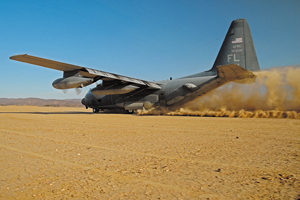 |
A USAF C-130 operated by the 81st Rescue Squadron lands on a dry lake bed in Djibouti. |
First, the three-day airlift of oversize vehicles, cranes, water purification systems, trailers, tents, and spare parts marked the first major operation for the Air Force component, also known as 17th Air Force.
Second, it marked a major effort to begin developing steady relationships on the large and diverse continent where the US has traditionally had limited interaction. “Americans tend to be episodic,” said Maj. Gen. Ronald R. Ladnier, commander of 17th Air Force. “There’s something going on, we roll into town, we help and then we leave, and they don’t see us for another few years. What we’re trying to do is sustain that engagement.”
The US-Rwandan cooperation opened the door to deeper collaboration barely two months later when the vice commander of 17th Air Force, Brig. Gen. Michael W. Callan, traveled to Kigali to meet with the chief of Rwanda’s Defense Force, Gen. James Kabarebe. The officers mapped a partnership to train and equip Rwanda’s air forces to deal more effectively with medical, logistical, and air traffic management issues in the nation of 10 million.
That meeting set the stage for a follow-up meeting led by the commander of AFRICOM, Army Gen. William E. Ward.
When the C-17s moved peacekeeping equipment from Rwanda to Sudan, Air Force trainers instructed 35 Rwandan counterparts in load preparation and loading, “so that the next time we go down there, they’ll be more prepared to load aircraft and support the next major operation,” Ladnier said. “We’re working like the dickens to not just throw events around but to tie them to a broader, long-term strategy.”
A Big Sustainment Piece
Typical of the wide-ranging engagements was a trip to Nigeria early this year by Lt. Col. David MacKenzie, deputy director of Air Forces Africa’s plans directorate. The veteran C-130 instructor pilot helped his Nigerian counterparts assess the status of that nation’s fleet of eight C-130s. The exercise found that only one of the aircraft was considered airworthy. This is a problem afflicting C-130s in Morocco and Libya, as well.
The US-Nigerian team concluded that consistent maintenance would be required to get Nigeria’s fleet airborne again. “It’s not just about fixing the aircraft,” MacKenzie said. “There is a big sustainment piece in the supply, logistics, and training areas.”
In many cases, national air forces in Africa “have hardware [but] they just haven’t had the same training” as US airmen, Ladnier said, and “have not kept the aircraft up to flying condition.”
Efforts by 17th Air Force, based at Ramstein AB, Germany, and Africa Command, based at Kelley Barracks in Stuttgart, Germany, represent so-called “active security” efforts. Active security is an evolving US strategy designed to help African nations bolster security, economic development, and political stability to exercise greater control over vast ungoverned spaces that might be used as safe havens or training grounds by al Qaeda and other radical extremists.
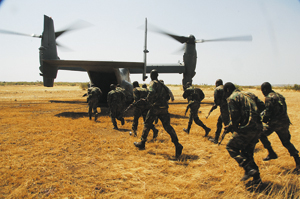 |
Malian and Senegalese military forces head for a CV-22 of USAF’s 8th Special Operations Squadron during the Flintlock joint training exercise in Mali. |
“Solutions to problems around the world are seldom one dimensional—seldom just military,” said Ladnier, who once served a three-year assignment as deputy director of contingency planning and peacekeeping at the State Department. “That is quite honestly what is so exciting about Africa.”
Air Forces Africa oversees some of the most visible assets that AFRICOM can deploy, even as it has no permanently assigned aircraft of its own and therefore relies upon attached forces. For example, two C-130s and 51 airmen from Dyess AFB, Tex., assigned to serve at Ramstein, have flown 173 sorties to deliver 274 tons of cargo on 98 different missions since Oct. 1. USAF’s Africa-wide totals since Oct. 1 have included delivering 1,100 passengers and 630 short tons of cargo on 216 sorties.
In March, 17th Air Force convened a five-day forum at Air University’s newly formed Air Force Research Institute, Maxwell AFB, Ala. The forum drew analysts and researchers from around the world to discuss ways to address the security challenges besetting a sprawling continent three times the size of United States, with 54 countries, 900 million people, and dozens of tribes and tongues.
“The one thing I have learned is there is no such thing as an ‘Africa expert,’” Ladnier said after the forum. “There are too many cultures, too many challenges, too many different conditions on the continent.”
It’s been an ambitious operational rollout for the revived 17th Air Force. President Bush’s order to create AFRICOM as the nation’s sixth geographic military command in 2007 resurrected the numbered air force, which had previously stood down in 1996.
AFRICOM drew together 172 separate Africa-related missions, activities, programs, and exercises from US European Command, US Central Command, and US Pacific Command when it became operational Oct. 1, 2008. Air Forces Africa was activated the same day. It presently relies on two C-130s attached to its headquarters at Ramstein, and two C-130Hs based in Djibouti.
Some Rough Spots
Yet after nearly a year of focusing exclusively on Africa, Ladnier said the scale of the continent still remains daunting. The 11-hour flight from Frankfurt, Germany, to Johannesburg, South Africa, is about as long as a flight from Frankfurt to Los Angeles.
Most African nations have airfields with runways and infrastructure sufficient to handle C-130s or C-17s. But fuel and fuel-handling equipment frequently is lacking, often forcing 17th Air Force to pre-position materiel and supplies. “Sometimes we just have to bring them in with us,” Ladnier said. “That is the biggest challenge to us.”
The start-up hasn’t always been smooth. The Government Accountability Office, for example, reported that high-level US officials had “raised concerns” that Africa Command might become the hub for all US efforts in Africa—thereby blurring “traditional boundaries between diplomacy, development, and defense.”
“To be quite honest, I have never understood that criticism,” countered Ladnier. Some $7.2 billion of the estimated $9 billion a year in US assistance to Africa comes from State Department-related agencies. “When I look at that money and then look at what the DOD budget is [for Africa]—about $250 million to $300 million—I don’t think we’re going to militarize anything with that budget.”
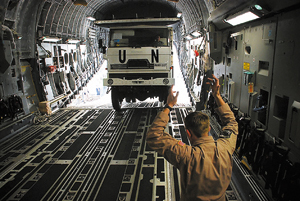 |
TSgt. Sean Arnold guides trucks bound for Sudan aboard a USAF C-17 at Kigali Airport in Rwanda. |
The GAO estimated that the overall cost to operate AFRICOM in Germany, expand DOD’s presence at 11 embassies in Africa, and improve facilities used by US forces in Djibouti could exceed $4 billion over seven years.
That price tag does not include an expense for establishing a forward headquarters in Africa, and US efforts in this regard have been met with mistrust. Liberia, on Africa’s west coast, remains the only nation to publicly express any interest in hosting the overall AFRICOM headquarters. The closest thing to a base the United States has on the continent is a 2,000-strong presence at Camp Lemonier in Djibouti, headquarters of the Combined Joint Task Force-Horn of Africa.
The African Union’s Pan-African Parliament vote in 2007 “not to accede” to the US request to “host AFRICOM anywhere in the African continent” has slowed efforts to locate a headquarters on the continent. Not a single African country stepped forward with an offer to host any of the five planned regional integration teams—small, lightly staffed miniheadquarters that were designed to enable AFRICOM to forge closer ties with African nations.
AFRICOM’s commander said that, for the time being, this is not a concern. “For many reasons, being on the continent today is not something that’s either necessary nor sought after,” Ward recently told lawmakers. “It is not the essential part of doing what we need to do to bring value added to our programs on the continent.” Africa Command will not decide where to seek a headquarters on the continent until 2012 at the earliest.
For his part, Ladnier said he would prefer to keep his headquarters at Ramstein, adjacent to 3rd Air Force headquarters, which runs USAF’s military operations in Europe. “If we get into something else that requires kinetic options, then the 3rd Air Force is ready to assist us with that,” he said. “My vote would be to stay here, because I think it makes us more successful.”
So far, US Air Force operations in Africa have largely focused on noncontroversial missions such as ferrying humanitarian relief supplies and peacekeepers’ equipment, conducting training, and working with African nations to improve air traffic control and air safety across a sprawling continent that suffers a disproportionate share of aircraft crashes and fatalities. But demanding—and potentially more controversial endeavors—could lie ahead in places such as Darfur.
US forces have intervened in Africa at least 42 times under various circumstances since 1956, according to the Congressional Research Service.
“Some of the greatest crimes against humanity have occurred in Africa, and periodically we hear calls for intervention,” observed Rep. Rodney P. Frelinghuysen (R-N.J.), a member of the House Appropriations Committee.
“There’s been talk of no-fly zones. … Are you ready?” Frelinghuysen asked Ward, who replied that enforcing no-fly zones “will require the allocation of forces to conduct [the] military work that would be required.”
On the Air Force side, Ladnier said his headquarters stands ready.
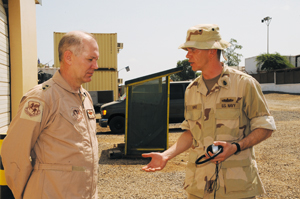 |
Maj. Gen. Ronald Ladnier, commander of US Air Forces Africa and 17th Air Force, talks to CPO James Drake in Djibouti. |
“Whatever may come up, we are prepared to bring all the capabilities that the Air Force can bring to a particular contingency,” Ladnier said. “We will work like heck … to keep problems from becoming crises. But if we’re asked to respond to catastrophe, then we’re ready to bring what the Air Force brings to any joint fight.”
In June, the 617th Air and Space Operations Center was activated to oversee air operations across Africa. But the greatest day-to-day challenge is still long-term planning. It is difficult to obtain the forces needed, even for the regularly scheduled military-to-military events that help deepen cooperation with African nations—it often takes three or four months to arrange for 17th Air Force to obtain forces for nonemergency operations such as scheduled military-to-military exercises.
Lily Pad Operations
Ladnier said this is “one area that we’re still wrestling with,” getting equipment and forces in place “in sufficient time to meet the engagement events that we have planned.”
But the command and its capabilities are still expanding. The Air Forces Africa staff is steadily growing—from the 125 who were on hand last October, to 180 airmen by April, toward a final goal of 286 personnel.
The command is building on-the-ground relationships on the continent by offering airlift, training, and aircraft maintenance assistance. Airmen are also offering to improve nations’ air traffic control capabilities to bolster various governments’ political control, economic development, and security.
As Ladnier said, “Better air travel in Africa will do in a similar way [for Africa] what the transcontinental railroad did for the United States.”
Seventeenth Air Force’s contingency and crisis planning and response team had already visited four African nations through April to carry out airfield surveys, with plans to visit seven more nations by Sept. 30. AFRICOM currently has cooperative security location agreements, commonly known as “lily pad” operating agreements, with a dozen African nations stretching from Algeria on the Mediterranean to Zambia and Botswana in southern Africa.
Military-to-military events, exercises, and conferences are on the increase, as well, with 30 events overseen by Air Forces Africa this year expected to grow to as many as 120 events next year. Countries involved just this year are expected to include Botswana, South Africa, Rwanda, Nigeria, Senegal, Cameroon, Ethiopia, Kenya, Mali, Ghana, Morocco, Nigeria, Algeria, Mozambique, Namibia, Uganda, and Sierra Leone.
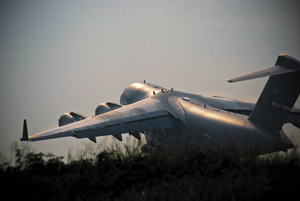 |
The USAF C-17 |
The US assistance could pay dividends by enabling countries such as Nigeria to provide airlift to African peacekeeping forces moving within the continent. This could include forces drawn from the seven Nigerian peacekeeping battalions being generated to support United Nations and African Union peacekeeping operations in Liberia, Sudan, and Somalia. A total of seven UN peacekeeping operations are under way across Africa, many drawing forces from some of the 60,000 African troops from 24 nations that have been trained under a US-financed program initially dubbed the African Contingency Operations Training Assistance Program.
Unfortunately, most African nations “have very limited ways to get people to the fight or sustain them when they are there,” MacKenzie said.
Also under way are efforts to partner US-based National Guard units with African nations for military-to-military familiarization and relationship building. Arrangements have led to Wyoming partnering with Tunisia; Utah with Morocco; North Dakota with Ghana; New York with South Africa; California with Nigeria; Vermont with Senegal; and North Carolina with Botswana.
Some US states have even dispatched local government officials and community business leaders to the partner countries in Africa. The goal is familiar—to build on the US military assistance and leverage it into broader ties that bolster commerce and trade.
The Air Force has high hopes that it can build beneficial relationships on a continent where US interests have often been underrepresented. “A lot of folks are watching us to see how it works out,” Ladnier said.
